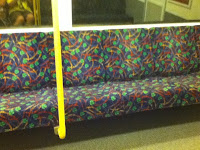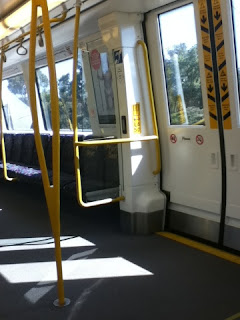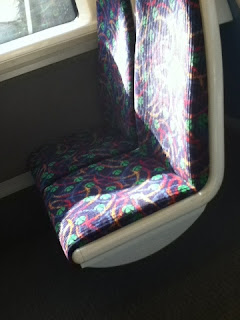Tommorow (20th February 2012), a new bus route will be trialled. It will be called the 451, and will run between Greenwood Train Station and Kingsway City Shopping Centre along Hepburn Av. The service will run only on weekdays, every 20 minutes from 6am to 9am and 4pm to 7pm, and hourly from 9am to 4pm. This route can only run on weekdays because it uses the sole bus stand at Greenwood, which is used by the 456 to Sorrento on weekends, meeting all daytime trains.
The route will take 17 minutes, 20 min with the midday deviations to Keith Simpson Masonic Homes, which is oddly takes longer than the 450, running to Warwick, which is further away, in 12 minutes.
It is a pity that there will be no weekend service, or service after 7pm, but the former require an additional bus stand, and the latter needs more operational funding.
The route is operating on a six month trial, after which the route's patronage will be reviewed, and while it is a useful link, its limited schedule does not help its chances.
A blog focused on public transport (PT) issues, particulary that in Perth (formerly A Transport Geek in Middle School)
Sunday 19 February 2012
Saturday 18 February 2012
Other service changes for the 19th of February 2012
Also up for service changes tomorrow will be Routes 23, 24, 25, 27, 28, 78, 79, 100, 101,102, 103, 107, 210, 211, 214, 403, 404 and 515
Routes 100 and 101 from Canning Bridge Train Station to Curtin University will get extra services during peak hour (2:30 pm onward in the afternoon) as well as extra 100s on Labour Day, Foundation Day and Queen's Birthday, when Curtin University still operates.
Route 78 connecting the Busport with the University of Western Australia (UWA) will get some extra services throughout the day.
The 214 from the Busport to Huntingdale will get a new afternoon peak short service, terminating a Thornlie, which leaves at 5:15pm, with the 5:17 bus now leaving at 5:20.
Routes 403 and 404 serving Tuart Hill and Joondanna on the journey from Wellington St Bus Station to Osborne Park will get some extra peak hour trips
All routes mentioned in the first sentence will get minor time changes.
Routes 100 and 101 from Canning Bridge Train Station to Curtin University will get extra services during peak hour (2:30 pm onward in the afternoon) as well as extra 100s on Labour Day, Foundation Day and Queen's Birthday, when Curtin University still operates.
Route 78 connecting the Busport with the University of Western Australia (UWA) will get some extra services throughout the day.
The 214 from the Busport to Huntingdale will get a new afternoon peak short service, terminating a Thornlie, which leaves at 5:15pm, with the 5:17 bus now leaving at 5:20.
Routes 403 and 404 serving Tuart Hill and Joondanna on the journey from Wellington St Bus Station to Osborne Park will get some extra peak hour trips
All routes mentioned in the first sentence will get minor time changes.
Service changes Routes 37-39 (Airport, Belmont, Kings Park)
On Sunday 19th of February there will be some changes to Routes 37, 38 and 39, serving the Domestic Airport (only the former), and Belmont, concerning their extension into Kings Park on weekends (except the weekday-only 38).
Previously , the 39 would extend to Kings Park on weekends (before 6:30pm on Saturdays), for half-hourly 39 service to Kings Park on Saturdays, and hourly service on Sundays. All 37 trips before 6pm would extend to Kings Park on Saturday, and on Sundays every second trip before 6:30 pm , plus an extra trip after that, would extend to Kings Park, for half hourly frequency on Saturdays and hourly on Sundays of 37s to Kings Park. This adds up to a 15 minute frequency on Saturdays and a 30 minute frequency on Sundays to Kings Park.
Under the changes the 39 will serve Esplanade Busport, instead of Kings Park, which will instead be solely served by the 37. To maintain current frequency all 37s will go to Kings Park on Sundays, and on Saturdays frequency will be doubled to every 15 min from Belvidere St / Gardiner St (Belmont), matching weekday frequency.
This high frequency does not extend to the Domestic Airport, which is what the route is designed to serve, but perhaps this just shows that its winding route through suburbia is not ideal for Airport service. The 36 and 40 used to deviate to the airport a few years ago, travelling straight along Great Eastern Highway, but that service was removed when airport management claimed a redevelopment plan would cause congestion with high levels of bus service (not adequately catering to buses?), which is unfortunate.
Route 39 will also go through some time changes, but no new service will be added.
While Route 39 users may lose a one-seat ride, that was a one seat ride only on every second trip. The changes will simplify the bus network, especially given that the 39 still went to the Busport, so now the 39 will have one route for the whole week.
Previously , the 39 would extend to Kings Park on weekends (before 6:30pm on Saturdays), for half-hourly 39 service to Kings Park on Saturdays, and hourly service on Sundays. All 37 trips before 6pm would extend to Kings Park on Saturday, and on Sundays every second trip before 6:30 pm , plus an extra trip after that, would extend to Kings Park, for half hourly frequency on Saturdays and hourly on Sundays of 37s to Kings Park. This adds up to a 15 minute frequency on Saturdays and a 30 minute frequency on Sundays to Kings Park.
Under the changes the 39 will serve Esplanade Busport, instead of Kings Park, which will instead be solely served by the 37. To maintain current frequency all 37s will go to Kings Park on Sundays, and on Saturdays frequency will be doubled to every 15 min from Belvidere St / Gardiner St (Belmont), matching weekday frequency.
This high frequency does not extend to the Domestic Airport, which is what the route is designed to serve, but perhaps this just shows that its winding route through suburbia is not ideal for Airport service. The 36 and 40 used to deviate to the airport a few years ago, travelling straight along Great Eastern Highway, but that service was removed when airport management claimed a redevelopment plan would cause congestion with high levels of bus service (not adequately catering to buses?), which is unfortunate.
Route 39 will also go through some time changes, but no new service will be added.
While Route 39 users may lose a one-seat ride, that was a one seat ride only on every second trip. The changes will simplify the bus network, especially given that the 39 still went to the Busport, so now the 39 will have one route for the whole week.
Wednesday 1 February 2012
The case for metros and tiering
Train systems in Australia often come as one product to serve a whole metropolitan area, which I think is best described as a suburban railway. This means that governments only have to maintain one rail-based product, saving resources, but this can cause problems as cities grow and public transport use grows faster than population.
To make trains attractive to suburban passengers, railway lines often skimp on stop spacing in inner areas to get passengers from the suburbs to the CBD quicker. This does not serve inner city areas adequately, even of there is already a railway line in the area. For example, the Mandurah line does not make any stops between the city and Canning Bridge, despite passing through dense or significant areas like South Perth or Como.
To deal with overcrowding capacity can be increased by measures that make use of existing rolling stock such as replacing seating with space for standees, such as longitudinal seating (along the sides rather than in pairs). However, this is unpopular with long distance commuters from suburban areas to the CBD who may be forced to stand for long periods of time. This seating is already common on A series trains, which do not serve far destinations except for the Armadale Line, but this modification is present at the ends of B-series trains, and is being rolled out on other parts of those sets, which are used on the 70 km Mandurah Line as well as the 30 km Joondalup Line, which is constantly extended to follow suburbia.

 The solution here is to split the suburban railway into two rail modes; the metro for inner areas, and the commuter railway for outer areas. Metros will have close stop spacing to serve inner suburbs thoroughly. Their use will be higher and service will be more frequent (TUAG) because inner areas are more conducive to public transport use, being built when cars were not available or not widely used. The trains may be driverless, or operated automatically by computer, to provide this service cheaply, and will feature full longitudinal seating, because average trip length will be shorter.
The solution here is to split the suburban railway into two rail modes; the metro for inner areas, and the commuter railway for outer areas. Metros will have close stop spacing to serve inner suburbs thoroughly. Their use will be higher and service will be more frequent (TUAG) because inner areas are more conducive to public transport use, being built when cars were not available or not widely used. The trains may be driverless, or operated automatically by computer, to provide this service cheaply, and will feature full longitudinal seating, because average trip length will be shorter.
On the other hand, commuter rail will have much wider stop spacing, for quick journeys from the outer suburbs to the city centre. Their frequency will be dictated by levels of use, which likely aren't as high as further in. But, of course, users of commuter rail will usually get a comfy seat.
Perth is part-way there, with the two tiers operating on the Armadale corridor (commuter to Armadale, metro to Thornlie) Monday to Saturday 6am to 12am, and supplemented on Sundays by an all stops service to Armadale. However, the rollingstock is still the same on both lines, the metro section (at least) should be grade separated, and of course the tiering should be full time, with the Thornlie line a bit more frequent.
The Midland and Fremantle lines are probably short enough to be metros, despite the express running in the peak, but again, grade separation is needed, and frequency could be better.
The Clarkson and Mandurah lines have inner tiers to Whitfords and Cockburn Central operating on the peak shoulder (formerly off-peak and the height of the peak before service cuts and fleet expansion respectively). This is completely grade separated but the stations are in freeway medians, and so are widely spaced and pedestrian/bike-unfriendly, the tier is part-time only and frequency needs a boost.
To make trains attractive to suburban passengers, railway lines often skimp on stop spacing in inner areas to get passengers from the suburbs to the CBD quicker. This does not serve inner city areas adequately, even of there is already a railway line in the area. For example, the Mandurah line does not make any stops between the city and Canning Bridge, despite passing through dense or significant areas like South Perth or Como.
To deal with overcrowding capacity can be increased by measures that make use of existing rolling stock such as replacing seating with space for standees, such as longitudinal seating (along the sides rather than in pairs). However, this is unpopular with long distance commuters from suburban areas to the CBD who may be forced to stand for long periods of time. This seating is already common on A series trains, which do not serve far destinations except for the Armadale Line, but this modification is present at the ends of B-series trains, and is being rolled out on other parts of those sets, which are used on the 70 km Mandurah Line as well as the 30 km Joondalup Line, which is constantly extended to follow suburbia.

 The solution here is to split the suburban railway into two rail modes; the metro for inner areas, and the commuter railway for outer areas. Metros will have close stop spacing to serve inner suburbs thoroughly. Their use will be higher and service will be more frequent (TUAG) because inner areas are more conducive to public transport use, being built when cars were not available or not widely used. The trains may be driverless, or operated automatically by computer, to provide this service cheaply, and will feature full longitudinal seating, because average trip length will be shorter.
The solution here is to split the suburban railway into two rail modes; the metro for inner areas, and the commuter railway for outer areas. Metros will have close stop spacing to serve inner suburbs thoroughly. Their use will be higher and service will be more frequent (TUAG) because inner areas are more conducive to public transport use, being built when cars were not available or not widely used. The trains may be driverless, or operated automatically by computer, to provide this service cheaply, and will feature full longitudinal seating, because average trip length will be shorter.On the other hand, commuter rail will have much wider stop spacing, for quick journeys from the outer suburbs to the city centre. Their frequency will be dictated by levels of use, which likely aren't as high as further in. But, of course, users of commuter rail will usually get a comfy seat.
Perth is part-way there, with the two tiers operating on the Armadale corridor (commuter to Armadale, metro to Thornlie) Monday to Saturday 6am to 12am, and supplemented on Sundays by an all stops service to Armadale. However, the rollingstock is still the same on both lines, the metro section (at least) should be grade separated, and of course the tiering should be full time, with the Thornlie line a bit more frequent.
The Midland and Fremantle lines are probably short enough to be metros, despite the express running in the peak, but again, grade separation is needed, and frequency could be better.
The Clarkson and Mandurah lines have inner tiers to Whitfords and Cockburn Central operating on the peak shoulder (formerly off-peak and the height of the peak before service cuts and fleet expansion respectively). This is completely grade separated but the stations are in freeway medians, and so are widely spaced and pedestrian/bike-unfriendly, the tier is part-time only and frequency needs a boost.
Labels:
capacity,
Commuter,
Congestion,
Development,
Fleet,
Frequency,
Infrastructure,
Joondalup Line,
longitudinal seating,
Mandurah Line,
Metro,
Perth,
Speed,
Stations,
The case for,
Tiering,
Trains,
TUAG
Subscribe to:
Posts (Atom)

